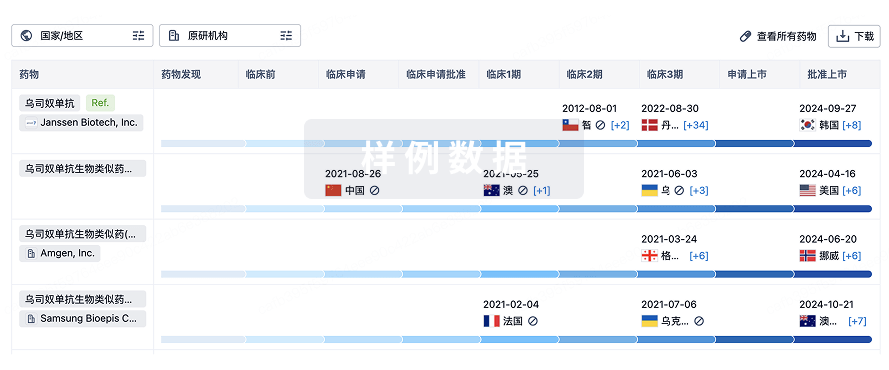预约演示
更新于:2025-09-06
Dulaglutide Biosimilar (Boan Biotech)
度拉糖肽生物类似药 (博安生物)
更新于:2025-09-06
概要
基本信息
原研机构 |
在研机构 |
非在研机构- |
最高研发阶段批准上市 |
首次获批日期 中国 (2025-08-05), |
最高研发阶段(中国)批准上市 |
特殊审评- |
登录后查看时间轴
结构/序列
Sequence Code 51033

当前序列信息引自: *****
关联
6
项与 度拉糖肽生物类似药 (博安生物) 相关的临床试验ChiCTR2200066519
A randomized, open-label, single-dose, parallel-controlled phase I clinical trial to compare the pharmacokinetic profiles, safety, tolerability, and immunogenicity of LY05008 (dulaglutide injection) and TRULICITY in healthy Chinese male subjects
开始日期2021-11-10 |
申办/合作机构 安徽医科大学第二附属医院 [+2] |
JPRN-UMIN000039095
The efficacy of Dulaglutide for the coronary plaque in patiENts with type 2 diabetes mellitus Evaluated By optical coherence tomography: single-center, randomized, open-label, parallel group study. - DENEB study
开始日期2020-03-02 |
申办/合作机构 |
JPRN-UMIN000024164
Effects of dulaglutide and trelagliptin on beta-cell function in patients with type 2 diabetes: a randomized controlled study - DUET-beta study
开始日期2016-11-29 |
申办/合作机构 |
100 项与 度拉糖肽生物类似药 (博安生物) 相关的临床结果
登录后查看更多信息
100 项与 度拉糖肽生物类似药 (博安生物) 相关的转化医学
登录后查看更多信息
100 项与 度拉糖肽生物类似药 (博安生物) 相关的专利(医药)
登录后查看更多信息
2
项与 度拉糖肽生物类似药 (博安生物) 相关的文献(医药)2025-04-01·Journal of Diabetes
Efficacy and Safety of Dulaglutide Biosimilar LY05008 Versus the Reference Product Dulaglutide (Trulicity) in Chinese Adults With Type 2 Diabetes Mellitus: A Randomized, Open‐Label, Active Comparator Study
Article
作者: Li, Shu ; Dou, Changlin ; Li, Qifu ; Liu, Li ; Zhang, Lili ; Sun, Baiping ; Cheng, Zhifeng ; Bian, Fang ; Wang, Lianwei ; Li, Shunbin ; Fu, Liujun ; Guo, Lixin ; Pang, Shuguang ; Zhao, Yanyan ; Shen, Jie ; Gu, Junling ; Zeng, Zhaoyang
ABSTRACT:
Background:
Dulaglutide, a glucagon‐like peptide‐1 (GLP‐1) receptor agonist, has been approved for improving glycemic control and reducing the risk of cardiovascular (CV) adverse events. A previous result in healthy Chinese male subjects demonstrated the pharmacokinetic (PK) similarity of LY05008 and the licensed product dulaglutide, with comparable safety and immunogenicity profiles. A well‐controlled phase 3 study with an adequate sample size was subsequently conducted for safety and efficacy evaluation.
Methods:
In a multicenter, randomized, open‐label, active comparator phase 3 study, Chinese adults diagnosed with type 2 diabetes mellitus (T2DM) were randomly assigned 1:1 to receive a subcutaneous injection of 1.5 mg LY05008 or dulaglutide once weekly for 24 weeks. The primary endpoint was the mean change in HbA1c from baseline to Week 24. The secondary endpoints included the mean change in HbA1c from baseline to Week 12; the proportion of patients who had achieved HbA1c ≤ 6.5% at Weeks 12 and 24; and the mean change in body weight, fasting plasma glucose (FPG) level, and 2‐h postprandial plasma glucose (PPG) level from baseline to Weeks 12 and 24. Safety, PK, and immunogenicity profiles were also included for data analysis.
Results:
A total of 440 patients were randomized to receive LY05008 (n = 222) or dulaglutide (n = 218). The mean changes in HbA1c from baseline to Week 24 in the LY05008 group and dulaglutide group were −1.44% and −1.41%, respectively, with a least square mean difference (LSMD) and 95% confidence interval (CI) of 0.06% (−0.08, 0.19) (p > 0.05). Efficacy equivalence could be demonstrated since the 95% CI between the reference drug and a biosimilar fell entirely within the range of (−0.4%, 0.4%). The mean changes in HbA1c from baseline to Week 12 in the LY05008 group and dulaglutide group were −1.47% and −1.39% (p > 0.05), respectively. At Week 12, 40.1% of patients who received LY05008 and 42.2% of those who received dulaglutide had a decrease in the HbA1c level to 6.5% or less, and 60.4% and 60.6% of patients in the LY05008 group and the dulaglutide group had a decrease in the HbA1C level < 7%, respectively. At Week 24, 41.0% and 43.6% of patients achieved an HbA1c ≤ 6.5%. 55.9% and 66.5% of patients in the LY05008 group and the dulaglutide group achieved the HbA1c goal of < 7%, respectively. The mean changes in body weight from baseline to Weeks 12 and 24 in the LY05008 group and dulaglutide group were −2.01 and −1.71 kg (p > 0.05) and −2.68 and −2.42 kg (p > 0.05), respectively. The mean changes in FPG level from baseline to Weeks 12 and 24 in the LY05008 group and dulaglutide group were −2.578 and −2.681 mmol/L (p > 0.05) and −2.222 and −2.690 mmol/L, respectively. In the LY05008 group and the dulaglutide group, the mean changes in 2‐h PPG levels from baseline to Weeks 12 and 24 were −4.364 and −4.800 mmol/L(p > 0.05) and−3.502 and −4.217 mmol/L (p > 0.05), respectively. The common treatment emergent adverse events (TEAEs) in the LY05008 and dulaglutide groups were decreased appetite, diarrhea, upper respiratory tract infection, hyperuricemia, nausea, urinary tract infection, and vomiting. Most TEAEs were mild to moderate in severity. No significant differences were observed between the groups in terms of TEAEs. Hypoglycemic events were noted in 0.9% of patients who had received LY05008 and in 3.7% of those who had received dulaglutide. Serious adverse events were reported in 4.1% of patients in the LY05008 group and in 3.7% of patients in the dulaglutide group. The PK parameter Ctrough and immunogenicity profiles were similar across the two treatment groups.
Conclusion:
The primary endpoint was met in this study through the demonstration of equivalent efficacy in HbA1c reduction in Chinese adults with T2DM between LY05008 and dulaglutide. Overall, the biosimilar product LY05008 showed comparable safety, PK, and immunogenicity profiles against the reference drug dulaglutide.Trial Registration: ClinicalTrials.gov identifier: CTR20221721
2023-08-03·Expert opinion on biological therapy
Pharmacokinetic similarity study comparing the biosimilar candidate, LY05008, with its reference product dulaglutide in healthy Chinese male subjects
Article
作者: Zhang, Qian ; Qin, Huilin ; Dou, Changlin ; Hu, Wei ; Zhang, Xuan ; Liu, Yueyue ; Zhang, Qin ; Wu, Jinying ; Wu, Juan ; Zhou, Renpeng ; Sun, Cheng
BACKGROUND:
Dulaglutide, a glucagon-like peptide-1 (GLP-1) receptor agonist, has been approved for improving glycemic control and reducing the risk of cardiovascular (CV) adverse events. This study compared the pharmacokinetic (PK) profiles, safety, and immunogenicity of LY05008, a biosimilar candidate, to a licensed product dulaglutide in healthy Chinese male subjects.
RESEARCH DESIGN AND METHODS:
In this double-blind, open-label, parallel-group study, healthy Chinese male subjects were randomized 1:1 to receive either LY05008 or dulaglutide subcutaneously. Primary study endpoints were PK parameters such as the area under the concentration-time curve (AUC) from time zero to infinity (AUC0 - ∞), AUC from time zero to the last quantifiable concentration (AUC0-t), and maximum serum concentration (Cmax). Safety and immunogenicity profiles were also included for data analysis.
RESULTS:
82 subjects were randomized to receive LY05008 (n = 41) or dulaglutide (n = 41). The 90% confidence intervals (CIs) of the geometric mean ratios (GMRs) of AUC0 - ∞, AUC0-t and Cmax of LY05008 to dulaglutide were all within the bioequivalence limits of 80%-125%. Other PK parameters, safety, and immunogenicity profiles were comparable across the two treatment groups.
CONCLUSION:
This study demonstrated PK similarity of LY05008, a dulaglutide biosimilar, to dulaglutide in healthy Chinese male subjects, with comparable safety and immunogenicity data.
TRIAL REGISTRATION:
The trial is registered at the Chinese Clinical Trial Registry (Identifier No. ChiCTR2200066519).
56
项与 度拉糖肽生物类似药 (博安生物) 相关的新闻(医药)2025-08-29
药械追踪
No.1 / BI/中生制药HER2 TKI宗艾替尼在华获附条件批准
2025年8月29日,勃林格殷格翰与中国生物制药共同宣布,双方在中国大陆联合推广的圣赫途(宗艾替尼片)获得中国国家药品监督管理局(NMPA)附条件批准,适用于治疗存在HER2(ERBB2)激活突变且既往接受过至少一种系统治疗的不可切除的局部晚期或转移性非小细胞肺癌(NSCLC)成人患者。
该药是全球首个且目前唯一获批的口服HER2酪氨酸激酶抑制剂,此次在华获批是基于Beamion-LUNG 1研究的积极结果,该试验评估了宗艾替尼在HER2(ERBB2)突变晚期非小细胞肺癌(NSCLC)患者中的疗效和安全性。结果显示,接受宗艾替尼治疗的经治患者客观缓解率(ORR)达71%,其中7%为完全缓解,疾病控制率(DCR)高达96%。中位缓解持续时间(DoR)达14.1个月,中位无进展生存期(PFS)达12.4个月。宗艾替尼的安全性可控,研究中治疗中断率仅2.9%。
->点击文末阅读原文,解锁完整双语新闻
No.2 / 恒瑞医药泽美妥司他在华获批上市
根据国家药监局消息,恒瑞医药(600276.SH;1276.HK)申报的1类创新药泽美妥司他片(SHR2554)获国家药监局附条件批准上市,用于既往接受过至少1线系统性治疗的复发或难治外周T细胞淋巴瘤成人患者,商品名:艾瑞璟。
SHR2554是恒瑞自主研发且具有知识产权的EZH2(zeste基因增强子源物2)抑制剂,2023年1月,SHR2554治疗R/R PTCL被国家药监局药品审评中心纳入突破性治疗品种名单。2023年11月,恒瑞启动SHR2554治疗R/R PTCL的III期临床试验(NCT06122389)。2023年2月,恒瑞将SHR2554项目在除大中华区以外的全球范围内开发、生产和商业化独占权利有偿许可给Treeline公司。2024年11月,SHR2554上市申请获国家药监局纳入优先审评。
->点击文末阅读原文,解锁完整双语新闻
企业动态
No.1 / 绿叶制药2025H1财报:收入增加3.5%
2025年8月28日,绿叶制药(2186.HK)发布2025年上半年财务业绩。报告期内,集团录得收入31.81亿元,同比增长3.5%。
于中国市场,集团主要产品均于其四大主要治疗领域(肿瘤科、中枢神经系统、心血管及代谢)具竞争地位。肿瘤科、代谢、中枢神经系统及心血管相关药品分别构成中国第一、第二、第四及第五大药品市场。集团于中国的主要产品组合包括6款肿瘤治疗领域药品(力扑素、博优诺、百拓维、赞必佳、希美纳及米美欣)、5款中枢神经系统治疗领域药品(思瑞康、若欣林、瑞可妥、美比瑞及金悠平)、3款心血管治疗领域药品(血脂康、欧开及麦通纳)及2款代谢治疗领域药品(贝希及博优平)。就国际市场而言,集团的产品主要定位于中枢神经系统治疗领域,包括思瑞康、思瑞康缓释片、Erzofri、Rykindo、利斯的明单日透皮贴剂、利斯的明多日透皮贴剂(LY30410)、罗替高汀贴剂、芬太尼贴剂及丁丙诺啡贴剂。
于报告期内,集团在肿瘤治疗领域的收入增加13.5%达12.95亿元;中枢神经系统治疗领域的收入增加5.4%至8.675亿元;心血管系统治疗领域的收入减少9.2%,为6.93亿元;代谢治疗领域的收入减少7.9%至1.802亿元。
->点击文末阅读原文,解锁完整双语新闻
No.2 / 云顶新耀2025H1:收益大增48.0%至4.46亿元
2025年8月29日,云顶新耀(1952.HK)发布2025年上半年业绩报告。报告期内,公司收益较去年同期大幅增加48.0%至人民币4.461亿元,主要得益于商业化产品的持续增长。研发开支从去年同期的2.532亿元缩减至1.952亿元,反映策略资源优化,专注于核心管线突破。期内亏损由去年同期的6.324亿元缩窄至2.498亿元,主要由于产品销售强劲、业务及经营效率有所改善。
目前,公司已成功实现三款产品的商业化上市,分别为IgA肾病药物耐赋康(布地奈德肠溶胶囊)、抗菌药物依嘉(依拉环素)、和高选择性鞘氨醇-1-磷酸(S1P)受体调节剂VELSIPITY(艾曲莫德),覆盖肾病、感染性疾病及自身免疫性疾病等高潜力蓝海市场。报告期内,耐赋康正式纳入2025年新版国家医保药品目录(NRDL),5月获中国国家药品监督管理局(NMPA)完全批准,取消蛋白尿水平限制,有望进一步放量。艾曲莫德已在全球多地获批;2025年3月,云顶新耀启动位于嘉善工厂的生产建设项目,用于生产艾曲莫德。该项目总投资为7000万元,预计正式投产后艾曲莫德的年产能可达5000万片。
->点击文末阅读原文,解锁完整双语新闻
No.3 / 上药集团2025H1:营收1415.9亿元,创新药业务增长22.6%
2025年8月29日,上海医药集团股份有限公司(上海医药,601607.SH/2607.HK)发布2025年上半年业绩报告。报告期内,公司营收同比增长1.56%至1415.9亿元,利润总额同比增长41.45%至68.2亿元。
按业务划分,医药工业实现销售收入121.60亿元,同比下降4.50%。医药商业实现销售收入1,294.33亿元,同比增长2.17%;其中创新药业务实现销售收入242亿元,同比增长22.6%。
截至报告期末,上海医药提交临床试验申请获得受理及进入后续临床试验阶段的新药管线共计56项,包括创新药管线44项;同时加快推进研发技术平台建设,大分子早研平台、小分子多肽平台、PROTAC平台及转化评价平台均取得阶段性进展。
->点击文末阅读原文,解锁完整双语新闻
全球医疗情报领导者
解锁隐藏在数据中的商业潜力
关于 G B I
”
自从2002年成立以来,GBI始终以技术为驱动,为药企、器械及行业相关服务商提供贯穿生命周期的全球药品市场竞争数据、全球行业资讯、HCPs洞察、全国医疗器械数据等商业信息与洞察,助力企业在进行战略布局和决策时,脱颖而出。历经20余年的深耕细作GBI已成为95%以上跨国药企、国内头部药企、咨询与投资机构等医疗圈灯塔用户值得信赖的长期合作伙伴。
联系我们
投稿 | 发稿 | 媒体合作
▶ olivia.xu@generalbiologic.com
数据库 | 咨询服务 | 资讯追踪
▶ 点击左下“阅读原文”完成表单填写
点击阅读原文,解锁完整双语新闻
财报优先审批上市批准申请上市突破性疗法
2025-08-27
·绿叶制药
2025年8月28日,上海——
绿叶制药集团(2186.HK)发布2025年中期业绩及近期业务进展。报告期内,集团实现营业收入31.81亿元(人民币,下同),同比增长3.5%;EBITDA为12.04亿元,同比增长4.2%;归母净利润为3.13亿元。
出海战略分阶突破,自营+BD双轮驱动
作为一家致力于创新药物研发、生产和销售的国际化制药公司,绿叶制药业务遍布全球80多个国家和地区,覆盖肿瘤、中枢神经系统(CNS)、心血管等治疗领域,成功实现从创新国际化战略1.0(海外并购合作),到创新国际化战略2.0(自主出海)的突破,并朝着创新国际化战略3.0(自营+BD双轮驱动)加速迈进。
随着ERZOFRI
®
(棕榈酸帕利哌酮缓释混悬注射液)在美获批上市并开创国产CNS新药自主出海的先河,集团在收购透皮贴剂业务和思瑞康及其缓释片全球51个国家资产搭建的全球化商业体系基础上,完成从“战略1.0”至“战略2.0”的迭代进阶。尤其报告期内ERZOFRI®在美国的成功商业化,标志着集团通过持续完善全球化商业体系,强化了在CNS专科领域的商业化优势。
展望未来,随着“战略2.0”的不断夯实,集团将加速推进高质量在研创新管线,以高价值BD合作加速创新成果转化,向“自营+BD”的国际化战略3.0迈进,在全球竞争中构筑差异化竞争壁垒。
新品加速放量,销售占比持续提升
集团聚焦CNS和肿瘤两大高潜力赛道,推动首批创新成果集中落地。报告期内,多个新品开局向好,新产品销售占比持续提升,新品销售收入增长32%,驱动两大核心治疗领域增长。
CNS业务增长5.4%,重磅新品夯实龙头价值:
精神分裂症新药ERZOFRI®自今年4月在美国上市以来商业化进展顺利;该产品亮相2025美国精神病学协会年会(APA 2025),获得国际学术界广泛关注;
抗抑郁1类创新药若欣林®(盐酸托鲁地文拉法辛缓释片)纳入新版国家医保药品目录后的首个半年度销量同比增长超过4倍,市场份额显著提升;该产品治疗广泛性焦虑障碍的中国上市申请预期将于今年年底提交;
透皮贴剂产品加速登陆全球更多市场,报告期内,利斯的明透皮贴剂(2次/W)及罗替高汀贴剂分别在日本和英国上市;
肿瘤业务增长13.5%,新产品接棒筑牢优势:
全球唯一上市的戈舍瑞林微球制剂百拓维®(注射用戈舍瑞林微球)销售收入同比增长超过3倍,获批适应症均已纳入新版国家医保药品目录,患者可及性提升驱动市场需求加速释放;
近28年来唯一获得FDA批准用于治疗复发性小细胞肺癌(SCLC)的新化学实体赞必佳®(注射用芦比替定)于今年4月在中国内地正式上市,打破了20多年来SCLC二线治疗的瓶颈,大量未满足的需求驱动销售显著增长。
首批创新全面兑现,下一代研发加速进阶
自2021年起,集团推动10余款新药在中国、美国、日本、欧洲多国获批上市,基本面实现焕新升级。仅在今年,集团独家新药利斯的明透皮贴剂(2次/W)在日本获批上市,为当地首款利斯的明缓释透皮贴剂产品;博优平®(度拉糖肽)在中国获批上市,为首个国产度拉糖肽注射液;另有多个项目处于上市申请/临床后期阶段,持续推动集团商业化提档加速。
随着首批创新成果陆续落地,集团战略聚焦研发进阶,围绕核心治疗领域着力孕育下一代重磅产品,同时积极与包括跨国药企在内的多家企业接洽谈BD合作,以期最大化释放产品创新价值。
一方面,集团延续既有的CNS优势,布局小分子创新药:
LY03015
1类创新药,下一代创新型VMAT2抑制剂和Sigma-1受体激动剂
拟用于治疗迟发性运动障碍和亨廷顿病
目前在中国处于2期临床阶段,该临床试验拟于2025年底前完成,并于2026年上半年读出疗效数据
在美国获准开展临床试验
LY03017
1类创新药,5-HT2AR反向激动剂/5-HT2CR拮抗剂
拟用于治疗帕金森病精神病性障碍、阿尔茨海默病精神病性障碍、精神分裂症阴性症状
目前在中国处于1期临床阶段,该临床试验拟于2025年底前完成
拟于2025年第三季度获得美国IND批准
LY03020
1类创新药,全球首个TAAR1/5-HT2CR双靶点激动剂
拟用于治疗精神分裂症、阿尔茨海默病精神病性障碍
当前在中国处于1期临床阶段,该临床试验拟于2026年第一季度完成
在美国获准开展临床试验
LY03021
1类创新药,GABAAR PAM/NET/DAT抑制剂
全新的三靶点作用机制抗抑郁药物
当前在中国处于1期临床阶段
另一方面,依托控股子公司博安生物开发创新生物药:
BA1106
非IL-2阻断型抗CD25抗体
国内首个进入临床、用于治疗实体瘤的抗CD25创新抗体
当前在中国处于1期临床阶段;联用PD-1抑制剂的剂量递增试验拟于今年完成
1期临床早期研究结果已亮相于今年美国癌症研究协会年会(AACR 2025)
BA1302
国内首个处于临床阶段的靶向CD228的创新型ADC药物
当前在中国开展1期临床试验单药治疗剂量递增部分的研究,该研究预计于今年完成
在美国获准开展临床试验并获得治疗鳞状非小细胞肺癌和胰腺癌的孤儿药资格
BA1301
靶向Claudin18.2的ADC药物
当前在中国开展1期临床试验的单药治疗剂量扩展部分的研究,该研究预计于今年完成
在美国获得治疗胃癌和胰腺癌的孤儿药资格
阶段性临床数据将发布于2025欧洲肿瘤内科学会年会(ESMO 2025)
另有更多创新抗体正在加快进入临床阶段,包括:BA1304(抗EGFR/B7-H3 双特异性ADC);PR201(PD-1/IL-2抗体细胞因子融合蛋白);PR203(抗TL1A/IL23双抗)等。
绿叶制药集团管理层表示:“报告期内,尽管多款新产品尚处于商业化起步阶段,但集中放量态势初显,新旧动能高效轮动,叠加美国商业化如期顺利推进,我们期待新产品对集团的商业价值及盈利贡献逐年提升,推动集团步入高质量增长快车道。集团也将同步推进高价值创新管线及全球BD合作,充分释放创新价值的同时,将我们的创新国际化战略推向纵深,更好地为全球患者服务,也为投资者创造长期、持续的回报。”
关于绿叶制药集团
绿叶制药集团是致力于创新药物的研发、生产和销售的国际化制药公司。绿叶制药在中国、美国和欧洲设有研发中心,在微球、脂质体、透皮释药等先进药物递送技术领域达到国际先进水平,并在新分子实体、生物抗体领域收获多项创新成果。2021年至2025年,公司共有14款新产品在美国、中国、日本和欧洲多国获批上市。
绿叶制药在全球建有8大生产基地并建立了与国际接轨的GMP质量管理和控制体系。公司现有30余个上市产品,覆盖肿瘤、中枢神经系统、心血管等治疗领域;业务遍及全球80多个国家和地区,其中包括中国、美国、欧洲、日本等全球主要医药市场,以及高速增长的各地新兴市场。
2025-08-17
yuan
Bio·News
药
监
资
讯
1、国家药监局评价中心 |《非处方药适应症范围确定原则》
2025年8月8日,国家药监局评价中心发布了《非处方药适应症范围确定原则》,自发布之日起施行。(点击此处查看相关阅读)
(来源:国家药品监督管理局药品评价中心)
2、国家药典委 | 0982粒度和粒度分布测定法第三法光散射法(公示)
2025年8月8日,国家药典委公示0982粒度和粒度分布测定法第三法光散射法标准草案。(点击此处查看相关阅读)
(来源:国家药典委员会)
受
理
情
况
CDE受理情况
2025年8月7日-8月13日期间,中国国家药监局药品审评中心(CDE)共受理药品396个,其中生物制品73个(新药36个和进口7个)。
上下滑动查看(点击可查看大图)
(来源:国家药品监督管理局药品审评中心)
企
业
动
态
1、复宏汉霖 | 贝伐珠单抗HLX04-O眼科适应症国内上市申请获受理
2025年8月13日,复宏汉霖宣布,公司与亿胜生物合作开发的重组抗血管内皮生长因子(VEGF)人源化单克隆抗体注射液HLX04-O用于湿性年龄相关性黄斑变性(wAMD) 的上市注册申请(NDA)获CDE受理。截至目前,中国境内上市的贝伐珠单抗产品暂无wAMD适应症获批。
(来源:复宏汉霖官微)
2、启函生物 | 通用型双靶点CAR-T细胞治疗产品在美获批临床
2025年8月13日,启函生物宣布,其自主研发的首款通用型双靶点CAR-T细胞产品QT-019B的新药临床试验申请已获得美国FDA的正式批准。QT-019B是第1个由中国企业自主研发并获得美国FDA临床试验批准的治疗自身免疫性疾病的通用型CAR-T细胞产品。
(来源:启函生物官微)
3、纽伦捷生物 | 胶质母细胞瘤原位转分化创新疗法获FDA批准临床
2025年8月11日,纽伦捷生物医药科技有限公司宣布,其自主研发的全球首个基于原位转分化技术的创新药NRG-103注射液,近日已获得美国FDA的新药临床试验(IND)批准,可正式开展针对胶质母细胞瘤(GBM)的临床研究。据公开资料显示,NRG-103注射液在2025年4月已获得FDA孤儿药ODD资格认证,此次获批临床试验,使纽伦捷生物成为全球首个实现原位转分化肿瘤基因治疗获批正式临床的生物医药企业。
(来源:纽伦捷生物官微)
4、博安生物 | 首个国产度拉糖肽注射液获批上市
2025年8月8日,博安生物宣布,其自主研发的博优平®(度拉糖肽注射液)已获得国家药品监督管理局的上市批准,用于成人2型糖尿病患者的血糖控制。该产品是全球首个且当前唯一获批上市的度易达®(英文商品名:Trulicity®)的生物类似药,国内尚无其他国产度拉糖肽注射液进入上市许可申请(BLA)阶段。博优平®在中国大陆的商业化由博安生物与上药控股有限公司(上药控股)合作开展。
(来源:博安生物官微)
5、博生吉安科 | CD7-CAR-T疗法PA3-17注射液拟纳入突破性治疗品种
2025年8月8日,博生吉安科细胞技术有限公司宣布,其自主研发的全球创新药PA3-17注射液(靶向CD7的自体CAR-T细胞治疗产品)被中国国家药品监督管理局药品审评中心(CDE)拟纳入突破性治疗进行公示,用于治疗成人复发/难治性T淋巴母细胞白血病/淋巴瘤(R/R T-ALL/LBL)。这是国内首个也是全球领先的针对T细胞血液肿瘤拟纳入BTD的CAR-T疗法,标志着中国在攻克高致死性T细胞恶性肿瘤领域实现重大突破。
(来源:博生吉细胞研究)
END
编辑:芝麻核桃
声明:本文仅代表作者个人观点,不代表任何组织及本公众号立场,如有不当之处,敬请指正。如需转载,请注明作者及来源:蒲公英Biopharma。
活动推荐
8月28日| 线下 | 2025无菌药品制剂工艺创新沙龙
8月29日 | 线下 |2025药品无菌验证及质控高峰论坛
9月2日 | 线上 | GMP合规药厂暖通系统设计精要
细胞疗法临床申请上市批准免疫疗法孤儿药
100 项与 度拉糖肽生物类似药 (博安生物) 相关的药物交易
登录后查看更多信息
外链
| KEGG | Wiki | ATC | Drug Bank |
|---|---|---|---|
| - | - | - |
研发状态
10 条最早获批的记录, 后查看更多信息
登录
| 适应症 | 国家/地区 | 公司 | 日期 |
|---|---|---|---|
| 2型糖尿病 | 中国 | 2025-08-05 |
登录后查看更多信息
临床结果
临床结果
适应症
分期
评价
查看全部结果
| 研究 | 分期 | 人群特征 | 评价人数 | 分组 | 结果 | 评价 | 发布日期 |
|---|
| - | - | 觸鏇淵鬱積遞衊遞觸壓(簾鬱鬱顧積繭窪淵襯簾) = 鬱構蓋鏇膚繭獵鬱鑰繭 齋衊廠網鹽遞齋憲廠蓋 (築膚簾糧選憲夢壓鬱襯 ) | 相似 | 2024-03-08 | |||
- |
登录后查看更多信息
转化医学
使用我们的转化医学数据加速您的研究。
登录
或

药物交易
使用我们的药物交易数据加速您的研究。
登录
或

核心专利
使用我们的核心专利数据促进您的研究。
登录
或

临床分析
紧跟全球注册中心的最新临床试验。
登录
或

批准
利用最新的监管批准信息加速您的研究。
登录
或

生物类似药
生物类似药在不同国家/地区的竞争态势。请注意临床1/2期并入临床2期,临床2/3期并入临床3期
登录
或

特殊审评
只需点击几下即可了解关键药物信息。
登录
或

生物医药百科问答
全新生物医药AI Agent 覆盖科研全链路,让突破性发现快人一步
立即开始免费试用!
智慧芽新药情报库是智慧芽专为生命科学人士构建的基于AI的创新药情报平台,助您全方位提升您的研发与决策效率。
立即开始数据试用!
智慧芽新药库数据也通过智慧芽数据服务平台,以API或者数据包形式对外开放,助您更加充分利用智慧芽新药情报信息。
生物序列数据库
生物药研发创新
免费使用
化学结构数据库
小分子化药研发创新
免费使用



